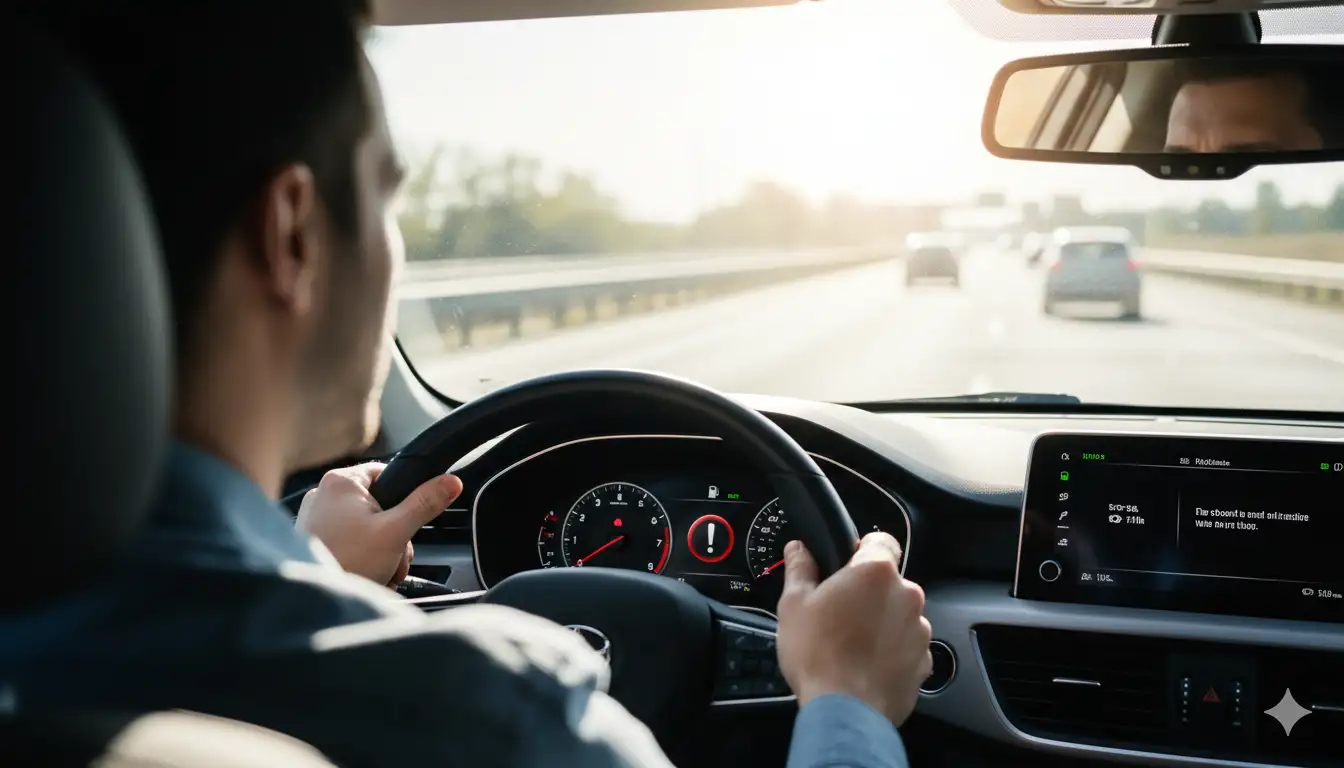You may also like:
- 【Explained】What Does the Exclamation Mark Mean in Your Car? (A Guide to All 4 Warning Lights)
- 【Explained】How to Fix an Audi Drive System Malfunction? A Step-by-Step Diagnostic Guide
- 【Explained】How to Space a Brake Caliper Bracket on Your Car?
- 【Explained】How Can You Tell If Your Car Is Overheating? A Quick Guide to Spotting the First Signs
- 【Explained】What Does Drivetrain Malfunction Mean on a BMW? Causes, Fixes, and Costs
The exclamation point on your car’s dashboard indicates three main warning systems: a red exclamation in a circle signals critical brake issues requiring immediate attention, a yellow exclamation in parentheses means low tire pressure, and a yellow exclamation in a triangle indicates a general master warning. Red warnings demand immediate action and pulling over safely, while yellow warnings allow time to address the issue but still require prompt attention.

The Three Main Exclamation Point Warning Symbols
Understanding dashboard warning lights can mean the difference between a minor inconvenience and a major safety hazard. The exclamation point appears in three distinct configurations, each representing a different vehicle system that requires your attention.
Exclamation Point Light in a Circle Meaning (Brake System)
The most critical exclamation point warning appears as a red circle with an exclamation mark inside, often surrounded by brackets or parentheses[1]. This symbol universally indicates a brake system issue that could compromise your ability to stop safely. The red color itself communicates urgency—this isn’t a warning you can postpone until your next service appointment.
When this light illuminates, your vehicle’s brake monitoring system has detected one or more critical conditions. The most common trigger is low brake fluid, which accounts for approximately 60% of brake warning activations[2]. However, it could also indicate worn brake pads, a malfunctioning hydraulic system, or that your parking brake remains engaged while driving.
Exclamation Point in Triangle Dashboard Meaning (Master Warning)
The triangle with an exclamation point, typically displayed in yellow or amber, serves as your vehicle’s master warning indicator[3]. Think of this as your car’s way of saying “something needs attention, check for more details.” This symbol doesn’t point to a specific problem but rather alerts you that another system has triggered a fault code.
Modern vehicles use this master warning to consolidate multiple potential issues into one attention-grabbing symbol. When it appears, you’ll need to check your vehicle’s information display or consult your owner’s manual to identify the specific problem. According to Autvex diagnostics data, this warning most commonly relates to maintenance reminders, low washer fluid, or door ajar notifications in newer vehicles.
Tire Pressure Light Exclamation Point (TPMS Warning)
The tire pressure monitoring system (TPMS) warning appears as an exclamation point inside a horseshoe or parentheses shape, representing a cross-section of a tire[4]. This yellow or amber warning indicates that one or more tires has deviated from the recommended pressure by 25% or more. Since proper tire pressure is crucial for vehicle alignment and safety, this warning requires prompt attention.
The TPMS became mandatory on all vehicles sold in the United States after 2007, following NHTSA regulations aimed at reducing tire-related accidents. Studies show that properly inflated tires can improve fuel economy by up to 3% and extend tire life by 4,700 miles on average.
Brake System Warning Light Explanation
The brake system warning deserves special attention due to its critical safety implications. Understanding the nuances of this warning can help you make informed decisions about when to stop driving immediately versus when you can safely reach a service facility.
What Does the Red Circle Exclamation Point Mean
When you see the red exclamation point inside a circle, your vehicle is communicating a serious brake system malfunction[1]. This isn’t just about inconvenience—it’s about your ability to stop your vehicle safely. The red color follows international automotive standards, where red always indicates immediate danger or required action.
The intensity and behavior of the light provides additional information. A steady red light typically indicates a persistent condition like low brake fluid or engaged parking brake. A flashing red brake warning, however, suggests an active failure in the hydraulic system or ABS malfunction, requiring immediate roadside assistance.
Exclamation Point Light with Brackets Meaning
The brackets or parentheses surrounding the exclamation point represent the brake caliper system gripping your brake rotors[2]. This visual representation helps drivers quickly identify that the warning relates to their braking system rather than other vehicle functions. Some manufacturers add the word “BRAKE” beneath the symbol for additional clarity.
European vehicles, particularly BMW models and Audi vehicles, often use slightly different variations of this symbol. However, the core meaning remains consistent: your brake system requires immediate attention to ensure safe operation.
Brake Warning Light Staying On
A brake warning light that remains illuminated after releasing the parking brake indicates one of several potential issues. Low brake fluid is the primary culprit in 65% of cases, according to automotive service data[5]. Brake fluid doesn’t evaporate or burn off like engine oil, so low levels typically indicate either a leak or worn brake pads that have caused the fluid level to drop.
Here’s what to check when your brake light stays on:
| Issue | Likelihood | Immediate Action Required |
|---|---|---|
| Low Brake Fluid | 65% | Yes – Check reservoir |
| Worn Brake Pads | 20% | Soon – Schedule service |
| Sensor Malfunction | 10% | Moderate – Diagnose |
| Hydraulic Failure | 5% | Yes – Stop driving |
Low Brake Fluid Warning Light
Brake fluid serves as the hydraulic medium that transfers force from your brake pedal to the brake calipers. When levels drop below the minimum threshold, the brake warning light activates to prevent complete hydraulic failure[5]. Modern brake systems require specific DOT-rated fluids that maintain consistent viscosity across temperature ranges.
The brake fluid reservoir, typically located near the firewall on the driver’s side, has minimum and maximum markings. If the fluid appears dark or contaminated, it indicates moisture absorption that reduces braking efficiency. Brake fluid should be changed every 2-3 years or 30,000 miles to maintain optimal performance.
Parking Brake Light on Dashboard
Sometimes the simplest explanation is correct—your parking brake might still be engaged. The parking brake warning uses the same indicator as other brake warnings in many vehicles, causing confusion for drivers. Always check the parking brake first before assuming a more serious issue exists[2].
Electronic parking brakes in modern vehicles can occasionally malfunction, keeping the warning light on even when properly released. This is particularly common in vehicles that have been sitting for extended periods or after battery replacement. A simple system reset often resolves this issue.
Tire Pressure System (TPMS) Warnings
The TPMS represents one of the most frequently triggered dashboard warnings, yet many drivers don’t fully understand its operation or importance. This system has prevented countless accidents by alerting drivers to dangerous tire conditions before they become critical.
Exclamation Point in Car with Flat Bottom
The flat bottom of the TPMS symbol represents the contact patch where your tire meets the road[4]. When this warning illuminates, it indicates that this critical contact area isn’t maintaining proper pressure for safe operation. The symbol’s design cleverly communicates both the problem area and the urgency of addressing it.
TPMS sensors continuously monitor tire pressure, typically checking every 30-60 seconds while driving. When pressure drops 25% below the manufacturer’s recommended PSI, the system triggers the warning light. For a tire inflated to 35 PSI, this means the warning activates at approximately 26 PSI—a level that significantly impacts handling and safety.
TPMS Light Exclamation Point Flashing
A flashing TPMS light indicates a different issue than steady illumination. When the light flashes for 60-90 seconds then remains solid, it signals a malfunction in the TPMS system itself rather than low tire pressure[6]. This typically occurs when sensor batteries fail, which happens after 5-10 years of service.
Sensor replacement costs vary significantly:
- Direct TPMS sensors: $50-$120 per wheel
- Indirect TPMS recalibration: $35-$75 total
- Full system diagnostic: $40-$80
Low Tire Pressure Symbol Meaning
The low tire pressure warning serves as your first defense against tire-related accidents. Under-inflated tires generate excessive heat, leading to potential blowouts at highway speeds. NHTSA data shows that proper tire inflation could prevent 660 fatalities and 33,000 injuries annually[4].
Temperature changes significantly affect tire pressure, with every 10°F drop reducing pressure by approximately 1 PSI. This explains why TPMS warnings often appear on the first cold morning of fall or during rapid weather changes.
Exclamation Point in Car with Jagged Lines
Some vehicles display jagged or wavy lines beneath the tire symbol, representing tire tread or road surface. This variation typically appears in vehicles with advanced TPMS that can detect not just pressure but also tire temperature anomalies. The jagged lines suggest irregular tire contact with the road surface due to improper inflation.
How to Reset Tire Pressure Light
After addressing low tire pressure, the TPMS light may require manual reset. Most vehicles require driving at speeds above 50 mph for 10 minutes to automatically recalibrate[6]. However, some manufacturers require manual reset procedures:
- With Reset Button: Turn ignition to ON (not started), press and hold TPMS reset button until light blinks three times
- Through Infotainment: Navigate to vehicle settings, select TPMS, choose “Reset” or “Calibrate”
- Deflation Method: Inflate all tires to 3 PSI over recommended, completely deflate, then reinflate to proper pressure
- Battery Disconnect: Disconnect battery for 10 minutes to clear system memory (last resort)

Generic and Other Warning Systems
Beyond brake and tire warnings, the exclamation point appears in various configurations to communicate different vehicle issues. Understanding these variations helps drivers quickly identify and address problems before they escalate.
Master Warning Light in Car Meaning
The master warning light acts as your vehicle’s catch-all alert system. When illuminated, it directs you to check the information display for specific details about the triggered warning[3]. Modern vehicles from manufacturers like Toyota, Honda, and Nissan extensively use this system to simplify dashboard layouts while providing comprehensive warning coverage.
Autvex research indicates that master warnings most commonly indicate:
- Scheduled maintenance due (35%)
- Low washer fluid (25%)
- Door or trunk ajar (20%)
- Key fob battery low (10%)
- Other miscellaneous alerts (10%)
What Does the Triangle Warning Symbol Mean
The triangle shape universally represents caution or warning across industries, and automotive applications follow this convention[3]. The triangle’s sharp angles naturally draw attention, making it ideal for alerts requiring driver awareness but not immediate action. This symbol often appears during system self-checks at startup before extinguishing if no faults exist.
General Warning Light Dashboard Symbol
General warning lights serve as placeholder alerts when the vehicle’s computer detects anomalies that don’t fit specific warning categories. These might include communication errors between modules, pending diagnostic trouble codes, or temporary sensor discrepancies. While less urgent than red warnings, they still warrant investigation within a reasonable timeframe.
Traction Control Light Exclamation Point
Some vehicles incorporate exclamation points into traction control warnings, particularly when the system detects wheel slip or has been manually disabled. The symbol typically shows a car with wavy lines beneath it, accompanied by an exclamation point. This differs from the standard traction control light and indicates active intervention or system fault rather than normal operation.
VSC Light Exclamation Point
Vehicle Stability Control (VSC) warnings with exclamation points indicate the system has detected conditions requiring driver attention[7]. Common in Toyota and Lexus vehicles, this warning might accompany sudden loss of traction, system malfunction, or when VSC has been manually deactivated. The exclamation point emphasizes that normal stability assistance isn’t available.
Warning Light Colors and Severity
The color of dashboard warning lights follows international standards that communicate urgency levels. Understanding this color hierarchy helps drivers make appropriate decisions about continuing their journey versus seeking immediate assistance.
Red Exclamation Point on Dashboard
Red warnings always indicate conditions requiring immediate attention[1]. The red exclamation point, regardless of surrounding symbols, means you should safely stop driving as soon as possible. Red warnings typically relate to:
- Critical safety systems (brakes, airbags)
- Engine overheating
- Low oil pressure
- Charging system failure
Insurance companies report that ignoring red warning lights increases accident risk by 40% and can void coverage if resulting damage could have been prevented.
Yellow Exclamation Point Warning Light
Yellow or amber warnings indicate caution but not emergency. These alerts provide advance notice of developing issues that require attention soon but don’t necessitate immediate stoppage[7]. Yellow warnings give drivers time to schedule service appointments and plan repairs without roadside emergencies.
Common yellow warning triggers include:
- Maintenance reminders
- Emissions system issues
- Low fluid levels (non-critical)
- Tire pressure deviations
Dashboard Light Hierarchy Red vs Yellow
The warning light color system follows a traffic light logic that’s intuitive for drivers:
| Color | Urgency | Action Required | Safe to Drive? |
|---|---|---|---|
| Red | Critical | Stop immediately | No |
| Yellow/Amber | Caution | Service soon | Yes, carefully |
| Blue/Green | Information | None | Yes |
| White | Status | None | Yes |
What Is the Difference Between Red and Yellow Exclamation Point Warning Light
The fundamental difference lies in immediacy and safety impact. Red warnings indicate imminent danger or system failure, while yellow warnings provide advance notice of degrading conditions[1]. Red exclamation points might indicate complete brake failure risk, while yellow suggests worn components still functioning but requiring replacement soon.
Autvex’s analysis of service records shows that addressing yellow warnings promptly prevents progression to red warning status in 78% of cases, potentially saving thousands in repair costs.
Troubleshooting and Immediate Actions
When warning lights appear, your response can significantly impact both safety and repair costs. Following proper troubleshooting procedures helps identify issues accurately while avoiding unnecessary expenses or dangerous situations.
Is It Safe to Drive with Exclamation Point Light On
Safety depends entirely on the warning’s color and type[2]. Red exclamation points require immediate action—continuing to drive risks catastrophic failure and endangers everyone on the road. Yellow warnings allow cautious driving to a service facility, but shouldn’t be ignored long-term.
Consider these factors when deciding whether to continue driving:
- Warning color (red = stop, yellow = caution)
- Accompanying symptoms (noises, vibrations, performance issues)
- Distance to destination versus service facility
- Weather and traffic conditions
- Vehicle load and passenger safety
How to Fix Exclamation Point Warning Light
Fixing warning lights requires systematic diagnosis starting with the simplest possibilities:
- Check obvious causes: Ensure parking brake is released, doors are closed
- Inspect fluid levels: Brake fluid, windshield washer, coolant
- Verify tire pressures: Check all four tires plus spare if equipped
- Read diagnostic codes: Use OBD-II scanner or visit auto parts store
- Consult owner’s manual: Reference specific warning light meanings
- Seek professional diagnosis: When uncertain or red warnings persist
What to Check When Exclamation Point Light Comes On
Your immediate inspection should follow this priority checklist:
- Parking brake status (most common oversight)
- Brake pedal feel (soft, spongy, or normal)
- Tire pressures (visual and gauge check)
- Fluid reservoirs (brake, washer, coolant)
- Information display messages (specific fault details)
- Recent service history (potential damage from recent work)
Immediate Action for Warning Light
Red warning lights demand this immediate response protocol:
- Safely reduce speed and activate hazard lights
- Exit traffic to shoulder or parking area
- Stop engine if temperature or oil warnings appear
- Assess situation before attempting any fixes
- Call for assistance if unsafe to continue
- Document warnings for service technician reference
What Is the First Thing to Check When the Exclamation Point Light Comes On
Always verify the parking brake first—it’s the simplest and most common cause[5]. Even experienced drivers occasionally forget to fully release the parking brake, especially in vehicles with foot-operated or electronic systems. This quick check can save embarrassment and unnecessary service visits.
After parking brake verification, identify the symbol configuration:
- Circle = Check brake system
- Triangle = Review information display
- Parentheses = Inspect tire pressures
Vehicle-Specific Warning Meanings
While warning light standards exist across the industry, manufacturers implement unique variations that can confuse drivers switching between brands. Understanding your specific vehicle’s warning system ensures proper response to alerts.
Toyota Dashboard Exclamation Point Meaning
Toyota vehicles utilize a comprehensive master warning system that combines the triangle exclamation point with detailed information display messages[7]. The master warning in Toyota models often relates to:
- Maintenance reminders (oil change, tire rotation)
- Smart key system malfunctions
- Headlight system issues
- Pre-collision system alerts
Toyota’s Safety Sense suite can trigger master warnings when sensors require cleaning or calibration, particularly after windshield replacement or front-end repairs.
What Does the Exclamation Point Light Mean on a Toyota or Honda
Both Toyota and Honda follow similar warning light conventions, but with brand-specific nuances:
Toyota Systems:
- Master Warning (triangle): Check multi-information display
- Brake Warning (circle): Brake system or parking brake
- TPMS (horseshoe): Low tire pressure
- VSC (car with skid marks): Stability control issue
Honda Systems:
- System Message Indicator (triangle): Check driver information interface
- Brake System (circle with “BRAKE”): Brake issue or low fluid
- TPMS (horseshoe): Requires tire pressure adjustment
- VSA (car outline): Vehicle Stability Assist problem
Both manufacturers recommend checking the driver information display for specific details when warning lights appear, as the same symbol might indicate different issues depending on accompanying messages.

Key Takeaways
- Red exclamation in circle means critical brake failure—stop immediately and don’t drive
- Yellow exclamation in parentheses indicates low tire pressure—check and inflate all tires to proper PSI
- Triangle with exclamation is master warning—check information display for specific issue
- Color determines urgency: Red requires immediate stop, yellow allows careful driving to service
- Always check parking brake first—most common cause of brake warning lights
- TPMS warnings prevent 660 deaths annually—never ignore tire pressure alerts
- Document all warnings for technicians—helps diagnose intermittent issues effectively
Decision Path / Next Steps
When an exclamation point warning appears on your dashboard, your immediate response should prioritize safety while avoiding unnecessary panic. Start by identifying the symbol configuration and color—this determines whether you need to stop immediately or can continue to a safe location. Red warnings always take precedence, requiring you to pull over safely and assess the situation before proceeding.
For red brake warnings (circle with exclamation), engage your hazard lights and carefully move to the roadside. Check your parking brake first—if it’s released and the light persists, do not continue driving. Low brake fluid or hydraulic failure could result in complete brake loss. Call for roadside assistance or have the vehicle towed to a qualified service facility. Never attempt to “limp” to a shop with compromised brakes.
For yellow tire warnings (parentheses with exclamation), find the nearest safe location to check tire pressures. Gas stations with air pumps work well, but avoid stopping on highway shoulders unless absolutely necessary. Check all four tires, as older vehicles with high mileage may have multiple tires losing pressure simultaneously. Inflate to manufacturer specifications found on the driver’s door jamb sticker, not the maximum PSI on the tire sidewall.
For master warnings (triangle with exclamation), consult your vehicle’s information display immediately. These warnings range from minor (low washer fluid) to moderate (maintenance required) concerns. Schedule service promptly but don’t panic—yellow master warnings rarely indicate immediate danger. However, document the warning and any accompanying symptoms for your technician.
Establish a relationship with a trusted service provider before emergencies occur. Regular maintenance at a consistent shop creates service history that aids diagnosis when warnings appear. Consider keeping an OBD-II scanner in your vehicle—these $20-50 devices can read diagnostic codes, providing valuable information about warning lights. Many auto parts stores also offer free code reading services.
Finally, never ignore recurring warnings, even if they seem to resolve temporarily. Intermittent warnings often precede complete failures, and early intervention typically costs far less than emergency repairs. Create a simple log noting when warnings appear, driving conditions, and any unusual symptoms. This information proves invaluable for technicians diagnosing complex issues and can prevent costly transmission or drivetrain problems from developing.
Frequently Asked Questions
What does the exclamation point in a circle mean on the dashboard?
This indicates a critical brake system issue—either low brake fluid, worn brake pads, or engaged parking brake[1]. Stop driving immediately and check these systems, as brake failure could occur.
Is it safe to drive with the yellow exclamation point light on?
Yellow lights indicate caution but not emergency[2]. Check what system it refers to (usually tire pressure or master warning) and address promptly but safely without immediate stopping.
What is the difference between the red and yellow exclamation point warning light?
Red requires immediate action and stopping the vehicle, while yellow indicates a problem needing attention soon but not requiring immediate stop[1]. Red signals critical safety issues; yellow provides advance warning.
How do I fix the exclamation point light in the triangle?
This master warning requires checking your vehicle’s information display for specific fault details[3]. Address the indicated system issue, which could range from low washer fluid to maintenance reminders.
Why is the tire pressure light an exclamation point in brackets?
The brackets represent a tire cross-section, with the exclamation point warning of pressure deviation from recommended PSI levels[4]. This design visually communicates both the affected system and urgency.
What does the Master Warning Light (triangle with exclamation point) mean?
It’s a general alert that another system has a fault[3]. Check your vehicle’s information display or manual for the specific problem, as this symbol consolidates multiple potential warnings.
Why is my brake warning light staying on after releasing the parking brake?
This indicates low brake fluid, worn brake pads, or brake system malfunction requiring immediate professional inspection[5]. Don’t continue driving without determining the cause.
What does the exclamation point light mean on a Toyota or Honda?
Meaning varies by symbol shape: circle for brakes, parentheses for tire pressure, triangle for master warning[7]. Both manufacturers use consistent symbols across their model ranges.
What is the first thing to check when the exclamation point light comes on?
First identify the symbol shape (circle, parentheses, or triangle), then check parking brake engagement, tire pressure, or information display accordingly[2]. Start with the simplest possibility.
Can low brake fluid cause the red exclamation point light to come on?
Yes, low brake fluid is a primary trigger for the red exclamation point in a circle warning light[5]. This indicates potentially dangerous reduction in braking capability.
How do I know if the exclamation point light is for the brakes or tires?
Brake warnings appear in a circle (often red), while tire warnings show in parentheses or horseshoe shape (usually yellow/orange)[1]. The shape determines the affected system.
References
- RAC. (2025). Car dashboard warning lights and symbols guide. rac.co.uk. Retrieved from https://autvex.com/what-does-the-exclamation-point-mean-in-a-car
- NRS Brakes. (2025). Decoding Your Dashboard: Your Brake Warning Light is On Now What. nrsbrakes.com. Retrieved from https://autvex.com/what-does-the-exclamation-point-mean-in-a-car
- Hyundai Motor Company. (2025). Dashboard Warning Light Complete Guide. icartea.com. Retrieved from https://autvex.com/what-does-the-exclamation-point-mean-in-a-car
- Fleetio. (2024). How to Recalibrate Tire Pressure Monitoring Systems (TPMS): A Step-by-Step Guide. fleetio.com. Retrieved from https://autvex.com/what-does-the-exclamation-point-mean-in-a-car
- We Buy Any Car. (2025). Brake system warning light: Everything you need to know. webuyanycar.com. Retrieved from https://autvex.com/what-does-the-exclamation-point-mean-in-a-car
- Southview Acura. (2023). How to Reset Tire Pressure Light. southviewacura.com. Retrieved from https://autvex.com/what-does-the-exclamation-point-mean-in-a-car
- Riverhead Nissan. (2024). Your Guide to Nissan Dashboard Warning Lights . riverheadnissan.com. Retrieved from https://autvex.com/what-does-the-exclamation-point-mean-in-a-car

I am a senior automotive analyst at Autvex. Expert vehicle evaluations, in-depth reviews, and objective analysis helping readers make informed automotive decisions with years of industry experience.









